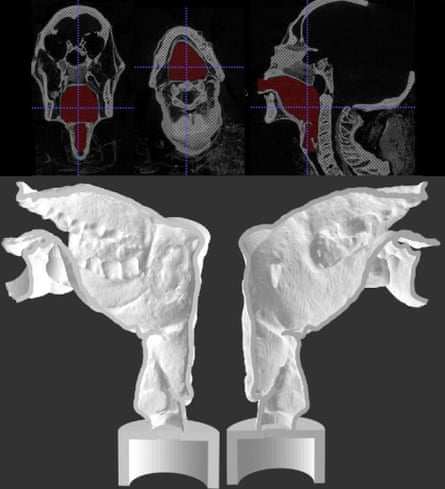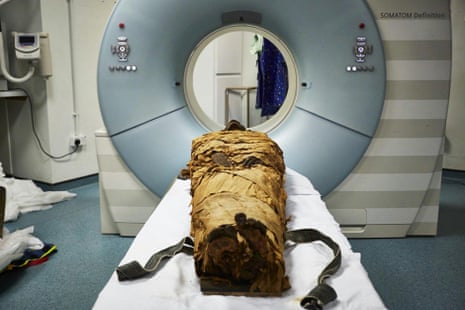The “voice” of an ancient Egyptian priest has been heard for the first time since he died and was mummified 3,000 years ago, researchers have said.
Nesyamun lived under the pharaoh Rameses XI, who reigned around the beginning of the 11th century BC.
Nesyamun’s mummy, currently in Leeds City Museum, has been the subject of much scrutiny: it was unwrapped in 1824, with subsequent work revealing that he was in his 50s when he died.
His death, which some suggested to have been from strangulation, was later proposed to be caused by an allergic reaction, possibly a result of an insect sting to the tongue – an unfortunate demise but one experts say may explain why the mummy had his tongue sticking out, but had no damage to the bones around his neck.
But while Nesyamun may have been unfortunate in death, he was lucky thereafter: his mummy was moved shortly before a bombing raid on Leeds in 1941 that destroyed the museum it had been in and many of its artefacts.
Now a team of researchers have 3D-printed a reproduction of Nesyamun’s vocal tract to hear what his voice would have sounded like.
“What we have done is to create the sound of Nesyamun as he is in his sarcophagus,” said the study co-author Prof David Howard, head of the department of electronic engineering at Royal Holloway, University of London. “It is not a sound from his speech as such, as he is not actually speaking.”
Writing in the journal Scientific Reports, the team revealed that they took the mummy to Leeds General Infirmary and carried out a series of CT scans. From these, the team were able to produce a digital reconstruction of Nesyamun’s vocal tract, and reproduce it through 3D printing.
However, mummification, burial and a long stretch of time had taken their toll: the tongue was shrivelled and the soft palate was missing – with the team having to virtually fill in the latter. They then coupled their model to an electronic larynx and loudspeaker.
The vocal tract filters sound produced from air that has passed through the larynx, with the resulting sound unique to each person. The position of different components of the vocal tract can then produce particular words or other vocalisations.
Howard said: “Our larynx sound is electronic and if that sound were produced by Nesyamun, he would be passing lung air outwards via his larynx where his vocal folds would be vibrating to create the same effect.”
If the insect-sting theory is correct, the last gasp of Nesyamun may have been expected to be “ow!” or “argh!”, but the team found that the vocalisation produced sounded rather like “eeuuughhh.”

But then, as Howard pointed out, the sound is more specifically that of Nesyamun lying in his coffin after mummification.
To better put their finger on the sound produced from Nesyamun’s vocal tract, the team analysed data and recordings from modern men and said the mummy’s sound fell somewhere between the vowels in “bad” and “bed”.
Howard said the dimensions of Nesyamun’s larynx and vocal tract suggest his voice would be slightly higher pitched than the average man today.
Nesyamun’s voice, the team wrote, would have been crucial to his work: he would have had to talk, chant or sing as part of his role as a priest, incense bearer and scribe at the temple of Karnak in Thebes. But it would also have been important after death.
“Every Egyptian hoped that after death their soul would be able to speak, in order for them to recite the so-called ‘negative confession’ telling the gods of judgement that they had led a good life,” said the study co-author Prof Joann Fletcher of the department of archaeology at the University of York. “Only if the gods agreed could the deceased soul pass through into eternity – if they failed the test they died a second, permanent death.”
Fletcher added those who passed the test were termed “true of voice” – a phrase that appears in Nesyamun’s coffin inscriptions alongside his name.
Prof John Schofield, an archaeologist and co-author of the study also at the University of York, said the team’s approach could offer the public a new way to engage with the past.
“It is just the sheer excitement and the extra dimension that this could bring to museum visits, for example, or site visits to Karnak,” he said.
“The idea of going to a museum and coming away having heard a voice from 3,000 years ago is the sort of thing people might well remember for a long time.”
“What we’d like to try to do next is develop a computer model that will allow us to move [the vocal tract] around and form different vowel sounds and hopefully, ultimately words,” he said.
“This [current sound] is never a sound he would have made in life, but from it we can create sounds that would have been made during his lifetime.”
Schofield added the approach could also be applied to other preserved human remains – such as the iron age bog bodies found in Denmark and beyond.
Salima Ikram, a professor of Egyptology at the American University in Cairo who was not involved in the work, said the study was “amazingly cool”, adding that it would be a useful comparison to make 3D-models from living humans to explore the accuracy of the approach.
“This study gives us a unique aural insight into the past and connects us intimately with Nesyamun, giving him a voice in the 21st century,” she said.
